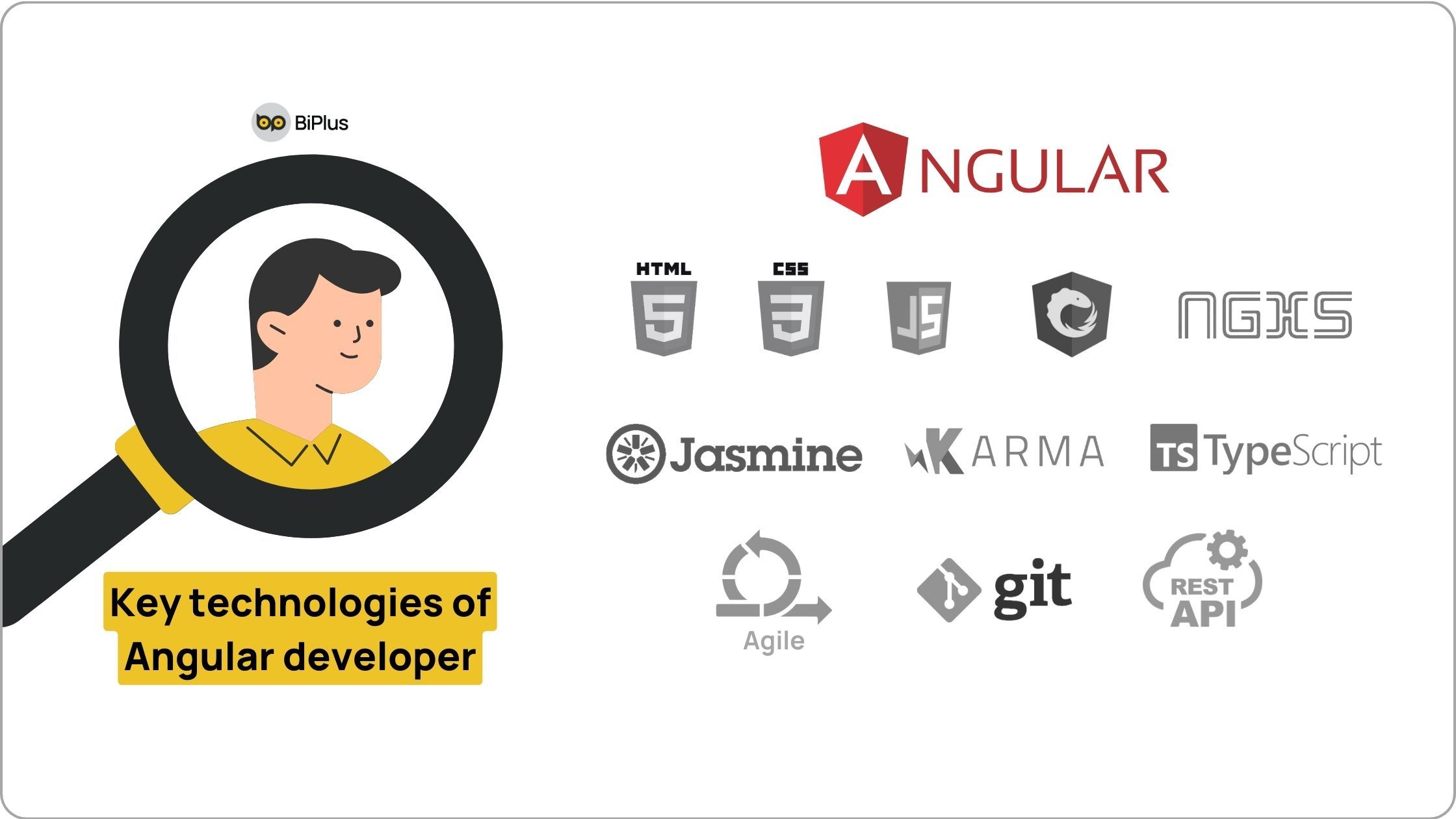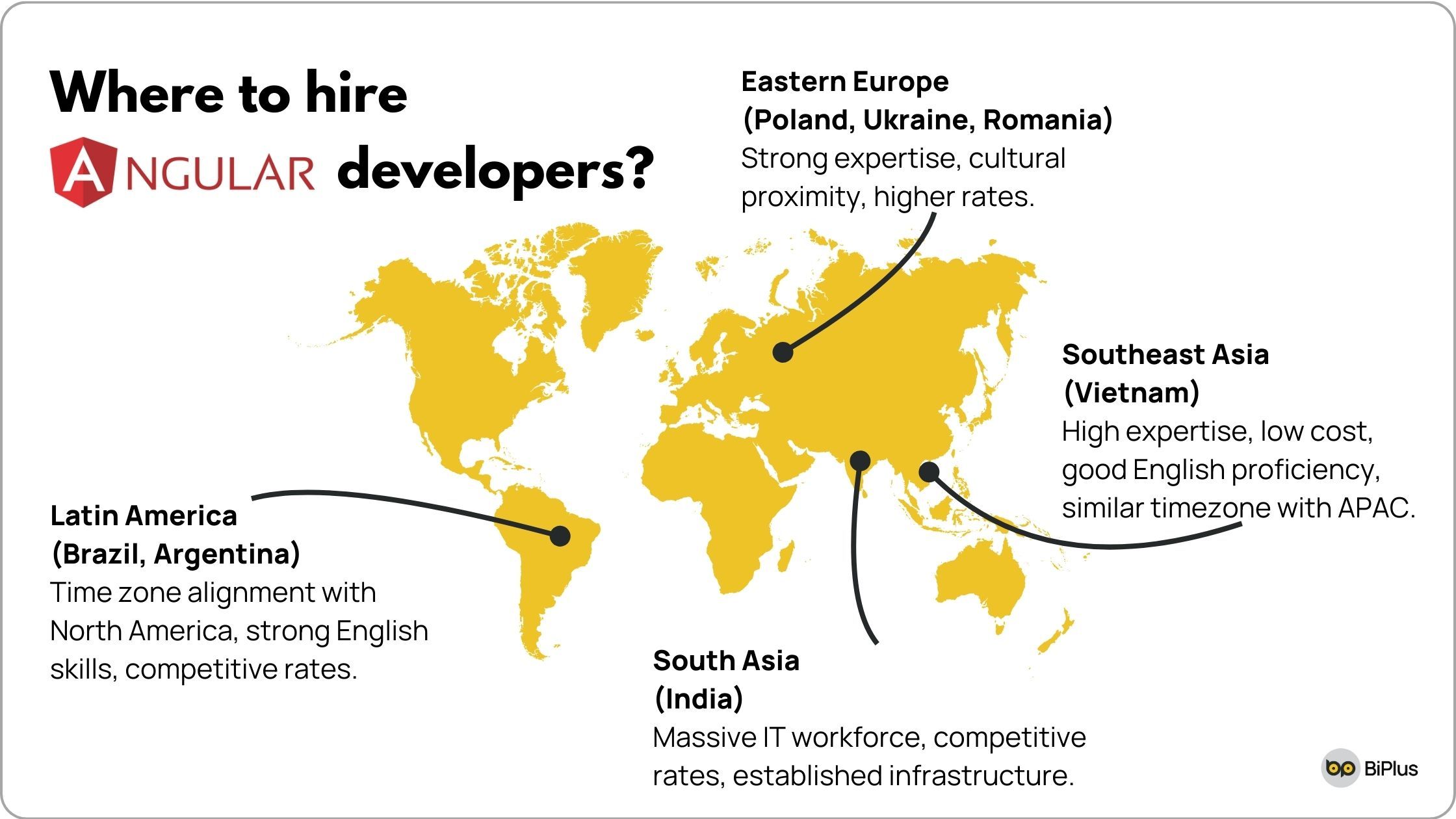Hiring the right Angular developer can feel a bit like navigating a maze.
There are so many questions to consider:
What skills to define a good Angular developer? How do you know they fit your projects or not? Do you have to pay high to hire skilled ones?
If you’re wondering about any (or all) of these, you’re in the right place.
In this guide, we’ll walk you through everything you need to know about hiring Angular developers - from what skills to look for and where to find them, to how much they might cost.
OK. Let's started!
Table of contents [ Hide ]
What is an Angular developer?
Typical Job Description (JD) of Angular developers
Key skills and technologies of Angular developers
Angular developer interview questions: the 10 most popular ones
What types of companies hire Angular developers?
How much does it cost to hire Angular developers?
Based on developer's location
Based on developer's expertise level
Based on pricing model
Based on hiring model
Tips on hiring Angular developers
Tip #1: Hire from low-cost countries with high Angular expertise
Tip #2: Assess technical depth beyond surface-level skills
Tip #3: Look for full development lifecycle experience
At BiPlus, we provide skilled Angular developers with low cost
What is an Angular developer?
An Angular developer is a front-end specialist who uses the Angular framework to build dynamic, single-page applications (SPAs) and progressive web apps (PWAs). They're the architects behind many modern web applications that deliver seamless user experiences.
Typical Job Description (JD) of Angular developers
Here are the key responsibilities typically handled by Angular developers:
- Design and implement user-facing features using Angular.
- Build reusable components and libraries for future use.
- Ensure high performance on mobile and desktop.
- Write clean, maintainable, and testable code.
- Optimize applications for maximum speed and scalability.
- Collaborate with back-end developers for API integration.
- Implement security and data protection measures.
- Create unit tests for behavior-driven development.
- Maintain documentation for future development and maintenance.
Key skills and technologies of Angular developers

To be considered a proficient Angular developer, professionals should be skilled in:
Core Technical Skills
- TypeScript
- HTML5 & CSS3
- JavaScript/ES6+
- RxJS and Observable patterns
- RESTful APIs integration
- State management (NgRx, NGXS)
- Unit testing (Jasmine, Karma)
Additional Technologies
- Version control (Git)
- Build tools (Webpack, npm)
- CSS preprocessors (SASS/SCSS)
- Responsive web design
- Cross-browser compatibility
- Performance optimization
- CI/CD practices
- Agile methodologies
Angular developer interview questions: the 10 most popular ones

1. What is Angular and how does it differ from AngularJS?
Angular represents a complete paradigm shift from AngularJS. While AngularJS was a JavaScript-based MVC framework, Angular is a TypeScript-based platform and framework for building scalable web applications. Key differences include:
- Architecture: Component-based (Angular) vs MVC (AngularJS)
- Language: TypeScript vs JavaScript
- Mobile Support: Built-in vs Limited
- Performance: Improved with Ivy renderer vs Slower digest cycle
- CLI: Advanced CLI tools vs No CLI
- Dependencies: Modern dependency injection vs Limited DI
Summary
- Complete rewrite in TypeScript
- Component-based architecture
- Better performance and mobile support
- Modern tooling and CLI
2. Explain Components in Angular
Components are the fundamental building blocks of Angular applications. Each component consists of:
- Template (HTML): Defines the view and user interface
- Class (TypeScript): Contains the component's logic and data
- Metadata (@Component decorator): Provides additional information about the component
- Styles: Component-specific CSS
Components follow a hierarchical structure where parent components can pass data to child components using @Input(). Child components can emit events to parents using @Output(). And components can be nested to create complex UIs.
Summary
- Basic building blocks of Angular apps
- Contains template, class, metadata
- Hierarchical structur
- Encapsulated functionality
3. What is dependency injection in Angular?
Dependency Injection (DI) in Angular is a design pattern and mechanism where classes receive their dependencies from an external source rather than creating them internally. Angular's DI system consists of:
- Injector: The service that holds dependency instances
- Provider: Tells the injector how to create the dependency
- Dependency: The service/value being injected
- Consumer: The class that needs the dependency
Summary
- Design pattern for managing dependencies
- Angular handles dependency creation and lifecycle
- Makes code more testable and maintainable
4. Describe the difference between Promises and Observables
Promises and Observables handle asynchronous operations differently:
Promises |
- Handle single events
- Cannot be canceled
- Always asynchronous
- Not lazy - execute immediately when created
- Cannot retry on error
|
Observables |
- Can handle multiple events over time
- Support cancellation through unsubscribe
- Can be synchronous or asynchronous
- Lazy - only execute when subscribed to
- Support retry and error handling operators
- Offer powerful operators (map, filter, merge, etc.)
- Enable complex data transformations
|
5. What are Angular Modules and why are they important?
Angular Modules (NgModules) are containers that group related code into functional sets. They consist of: Declarations (components, directives, pipes), Imports (other modules needed), Exports (declarations available to other modules), Providers (services) and Bootstrap (root component).
Key aspects:
- Every Angular app has at least one module (root module)
- Modules can be eagerly or lazily loaded
- Feature modules organize code by functionality
- Shared modules contain reusable components
- Routing modules manage navigation
Summary
- Organizational units for related code
- Enable lazy loading for better performance
- Manage component and service boundaries
- Essential for scalable application architecture
6. Explain Angular's change detection strategy
Change detection determines how Angular checks for data changes and updates the DOM. There are two main strategies: Default and OnPush.
Default |
- Checks all components on every change
- More predictable but less performant
- Runs after every event that can change data
|
OnPush |
- Only checks component on specific triggers
- More performant but requires careful implementation
- Triggers include: Input reference changes, event emissions, async pipe updates, and manual detection
|
7. What are Angular Services and when should you use them?
Angular services are singleton objects that provide shared functionality such as: data sharing between components, business logic implementation, external API communication, state management and utility functions.
Key characteristics:
- Injectable through dependency injection
- Singleton by default within their injection scope
- Can be provided at different levels
- Support inheritance and composition
- Enable separation of concerns
8. How do you handle routing in Angular?
Angular Router enables navigation between views:
Key features:
- Path configuration with components
- Route parameters and query strings
- Child routes for nested views
- Route guards for access control
- Lazy loading for better performance
- Navigation events for tracking
Common patterns:
- Using RouterLink directives
- Programmatic navigation
- Route resolvers for data
- Location strategies
- Custom route reuse strategies
9. What are Angular Directives and their types?
Angular Directives are markers that tell Angular to modify the DOM or element behavior.
There are 3 types:
Components |
- Directives with templates
- Most common type
- Have their own selector
|
Structural Directives |
- Modify DOM layout
- Examples: *ngIf, *ngFor, *ngSwitch
- Can create/destroy elements
|
Attribute Directives |
- Change appearance/behavior
- Examples: ngClass, ngStyle
|
10. How do you optimize Angular applications for performance?
Performance optimization involves multiple strategies:
Build-time optimization |
- Ahead-of-Time compilation
- Tree shaking unused code
- Production mode builds
- Code splitting and lazy loading
|
Runtime optimization |
- OnPush change detection
- Pure pipes
- TrackBy for *ngFor
- Unsubscribing from Observables
|
Loading optimization |
- Preloading strategies
- Resource prioritization
- Caching strategies
- Server-side rendering
|
What types of companies hire Angular developers?
Many companies across various industries are actively seeking talented Angular developers to build and maintain their modern web applications.
Technology giants like Google, Microsoft, and Meta heavily rely on Angular developers for building their enterprise-grade web applications and internal tools. Google, in particular, uses Angular extensively across its product suite, from Google Cloud Platform interfaces to internal dashboards.
The financial services sector, particularly investment banks, trading platforms, and fintech companies, represents a major employer of Angular developers. Companies like JPMorgan Chase, PayPal, and Stripe leverage Angular's robust architecture to build secure, high-performance trading platforms, banking dashboards, and payment processing interfaces.
E-commerce and retail companies such as Amazon, Walmart, and Nike need Angular developers to create seamless shopping experiences. Their Angular teams work on critical features like product catalogs, shopping cart systems, and customer account management portals that handle millions of daily transactions.
The healthcare and medical technology sector, including organizations like UnitedHealth Group, Philips Healthcare, and Epic Systems, employs Angular developers to build sophisticated patient management systems. These companies use Angular to create intuitive interfaces for electronic health records, medical imaging viewers, and appointment scheduling systems.
Media and entertainment companies such as Netflix, HBO, and Spotify rely on Angular developers to build engaging streaming platforms. Their teams create complex user interfaces that handle content delivery, user recommendations, and interactive media players serving millions of concurrent users.
The travel and hospitality industry, with companies like Booking.com , Airbnb, and Expedia, utilizes Angular developers to build dynamic booking platforms. These companies leverage Angular's powerful features to create responsive interfaces for travel planning, property management, and real-time availability systems.
The IT services/IT outsourcing sector, including companies like Accenture, Deloitte, and Capgemini, consistently hires Angular developers to support their client projects.
How much does it cost to hire Angular developers?
Based on developer's location
The cost of hiring Angular developers varies significantly by region due to economic factors, market maturity, and technical education standards.
North America & Western Europe: Highest rates due to mature tech markets and high living costs. Here, you can expect developers with strong experience in enterprise applications, a good grasp of best practices, and cultural alignment with Western businesses. Same or similar time zones with US/EU clients is an added benefit. However, premium rates can strain budgets, there's high competition for talent, and turnover can be higher.
Eastern Europe & Latin America: Many developers have a strong theoretical foundation, problem-solving skills, and there's a growing Angular ecosystem. Some challenges include potential cultural differences, varying levels of English proficiency, and regional political instability.
Asia: These regions have large talent pools with strong technical education. While rates are very competitive, there are significant time zone differences with the West, and communication barriers may exist. Quality can vary, and projects may need more management oversight.
Here's an overview of estimated monthly salary for Angular developers in different regions:
Estimated annual salary for Angular developers in different regions
| Region | Median Annual Salary (USD) |
|---|
North America | $70,000 - $100,000 |
Western Europe | $50,000 - $70,000 |
Eastern Europe | $30,000 - $40,000 |
Latin America | $30,000 - $45,000 |
South Asia | $20,000 - $30,000 |
Southeast Asia | $22,000 - $35,000 |
East Asia | $35,000 - $55,000 |
Based on developer's expertise level
Junior Angular Developers (0-2 years): They are proficient in basic Angular concepts and simple CRUD operations but need regular supervision and work best with structured tasks.
Mid-Level Angular Developers (2-4 years): They can handle advanced component architecture, state management, and performance optimization but may still need guidance for complex architecture and best practices.
Senior Angular Developers (5+ years): They are skilled in complex architecture, performance optimization, and security, often providing team leadership and mentoring. They add value by making architectural decisions and mentoring juniors.
The following shows estimated salary of Angular developers based on experience:
Estimated annual salary for Angular developers based on experience
| Region | Junior (USD) | Middle (USD) | Senior (USD) |
|---|
North America | $50,000 - $70,000 | $70,000 - $100,000 | $100,000 - $140,000 |
Western Europe | $40,000 - $60,000 | $50,000 - $70,000 | $70,000 - $85,000 |
Eastern Europe | $205000 - $35,000 | $30,000 - $40,000 | $40,000 - $50,000 |
Latin America | $20,000 - $35,000 | $30,000 - $45,000 | $40,000 - $65,000 |
South Asia | $15,000 - $25,000 | $20,000 - $30,000 | $25,000 - $35,000 |
Southeast Asia | $18,000 - $30,000 | $22,000 - $35,000 | $30,000 - $45,000 |
East Asia | $30,000 - $45,000 | $35,000 - $55,000 | $50,000 - $80,000 |
Based on pricing model
Different pricing structures can affect the overall cost:
- Hourly rates: Flexible but can vary widely, typically ranging from $15 to $100 per hour.
- Fixed price: Offers cost certainty for specific projects but may be less flexible for changes.
- Retainer: Regular payment for ongoing work, often at a slightly discounted rate.
Here's a comparison of different pricing models:
Comparison of different pricing models for hiring Angular developers
Hourly rates | $15-100 per hour |
Fixed price | Project dependent, typically $8,000-80,000+ |
Retainer | $2,500-12,000+ per month |
Based on hiring model
- Full-time employees: Higher initial investment, better for long-term projects.
- Freelancers: Flexible but potentially higher rates.
- Outsourcing companies: Balance of cost and managed services.
Tips on hiring Angular developers
Tip #1: Hire from low-cost countries with high Angular expertise

Eastern Europe, Latin America, and Asia stand out as prime hiring regions for Angular talent, offering an optimal balance of expertise and cost-effectiveness. These areas have emerged as technology hubs with strong JavaScript ecosystems and extensive Angular adoption.
Highlight countries include: Vietnam, India, Philippines, Poland, Brazil.
Here are som key advantages of these regions:
- Large pools of experienced developers with strong Angular fundamentals.
- Lower operational costs compared to Western and North America markets.
- Strong technical education systems.
- High English proficiency levels.
Tip #2: Assess technical depth beyond surface-level skills
When you're interviewing candidates, don't just focus on their list of technical skills.
You want to hear their stories about solving real problems. Ask them about tough projects they've handled or complex performance issues they've fixed. Have them walk you through their thought process.
You'll learn more about a developer's true capabilities and how they'll handle problems on your team.
Tip #3: Look for full development lifecycle experience
Finally, you'll want someone who understands the bigger picture of software development. Look for developers who can tell you about working with different teams, reviewing others' code, and writing clear documentation.
The ideal Angular developer should also be able to tell you about their experience with automated testing, deployment pipelines, and working in an agile environment.
At BiPlus, we provide skilled Angular developers with low cost
As an IT outsourcing company based in Vietnam, BiPlus offers high-quality Angular developers at competitive rates. Our teams have successfully delivered various projects, from e-commerce platforms to enterprise applications.
We offer:
- Experienced Angular developers at competitive rates (40-60% cost savings)
- Strong English communication skills
- Scaled Agile development approach
- Flexible time zone arrangements
- Proven track record with global clients
Here are some case studies of how our Java developers helped clients succeed.
Check them out!
Telecom: Enhancement of Billing & Customer Care systems in 10 nations.
Transportation: Payment services integration for an ETC app.
Ready to build your Angular development team?
Book a quick meeting with our Angular teams to discuss your needs.



















